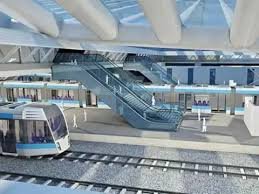Introduction
India has taken a significant step toward the modernization of its railway infrastructure with the establishment of its first private railway station. This initiative is aimed at improving passenger amenities, increasing operational efficiency, and reducing the burden on the Indian Railways. This move is expected to set a precedent for future public-private partnerships (PPP) in the railway sector.
Which is India’s First Private Railway Station?
The first private railway station in India is Habibganj Railway Station in Bhopal, Madhya Pradesh. This station was redeveloped under the Public-Private Partnership (PPP) model by the Bansal Group, a private entity. The project aimed to transform the station into a world-class facility with modern amenities.
Key Features of the Redeveloped Habibganj Station
- World-Class Infrastructure: The station has been equipped with modern waiting lounges, food courts, air-conditioned halls, and clean restrooms.
- Enhanced Security: The station features CCTV surveillance, fire safety equipment, and increased security personnel.
- Eco-Friendly Approach: The redevelopment incorporated green energy solutions, including solar panels and rainwater harvesting.
- Commercial Development: The PPP model allows for commercial spaces to generate revenue for the maintenance of the station.
- Improved Passenger Experience: The upgraded facilities provide a seamless and comfortable journey experience for travelers.

Why This News is Important?
Boost to Public-Private Partnership (PPP) Model
The success of this project highlights the potential of public-private partnerships in enhancing India’s railway infrastructure. It paves the way for more such collaborations in the future.
Modernization of Railway Infrastructure
Indian Railways is one of the largest railway networks in the world. The privatization and redevelopment of stations ensure better maintenance, improved passenger experience, and efficient operations.
Economic Growth and Employment Generation
Such projects contribute to the local economy by generating employment opportunities in the construction, retail, and services sectors, thereby boosting economic growth.
Historical Context
Indian Railways, established in 1853, has been under government control for over a century. While private participation has been seen in freight operations and manufacturing, the Habibganj project is a landmark step in station management privatization. The station was originally built in 1979, and its transformation into India’s first private railway station marks a new era in railway reforms.
Key Takeaways from India’s First Private Railway Station
| S.No | Key Takeaway |
|---|---|
| 1 | Habibganj Railway Station in Bhopal is India’s first private railway station. |
| 2 | The station was redeveloped under a Public-Private Partnership (PPP) model. |
| 3 | The Bansal Group was responsible for the redevelopment project. |
| 4 | The station features modern infrastructure, security enhancements, and eco-friendly initiatives. |
| 5 | This initiative sets a precedent for future private investments in Indian Railways. |
FAQs: Frequently Asked Questions
- Which is the first private railway station in India?
- Habibganj Railway Station, now known as Rani Kamlapati Railway Station, was the first private railway station in India.
- Who operates the first private railway station in India?
- It is operated by the Bhopal-based Bansal Group under a Public-Private Partnership (PPP) model with the Indian Railways.
- When was Habibganj Railway Station redeveloped?
- The redevelopment project was initiated in 2016 and was completed in 2021.
- What are the key features of India’s first private railway station?
- The station boasts modern amenities such as airport-style lounges, better cleanliness, food courts, and advanced security measures.
- What is the significance of the PPP model in railway infrastructure?
- The Public-Private Partnership (PPP) model helps improve railway infrastructure by involving private entities in funding and management while retaining government oversight.
Some Important Current Affairs Links


















 Exciting News!
Exciting News!  Join Our Telegram Channel Now!
Join Our Telegram Channel Now!
 Join our Telegram channel for a thrilling adventure into the world of daily current affairs.
Join our Telegram channel for a thrilling adventure into the world of daily current affairs. 
 Don’t miss out on the latest updates and insights! Click to join now and be part of the knowledge revolution!
Don’t miss out on the latest updates and insights! Click to join now and be part of the knowledge revolution! 
